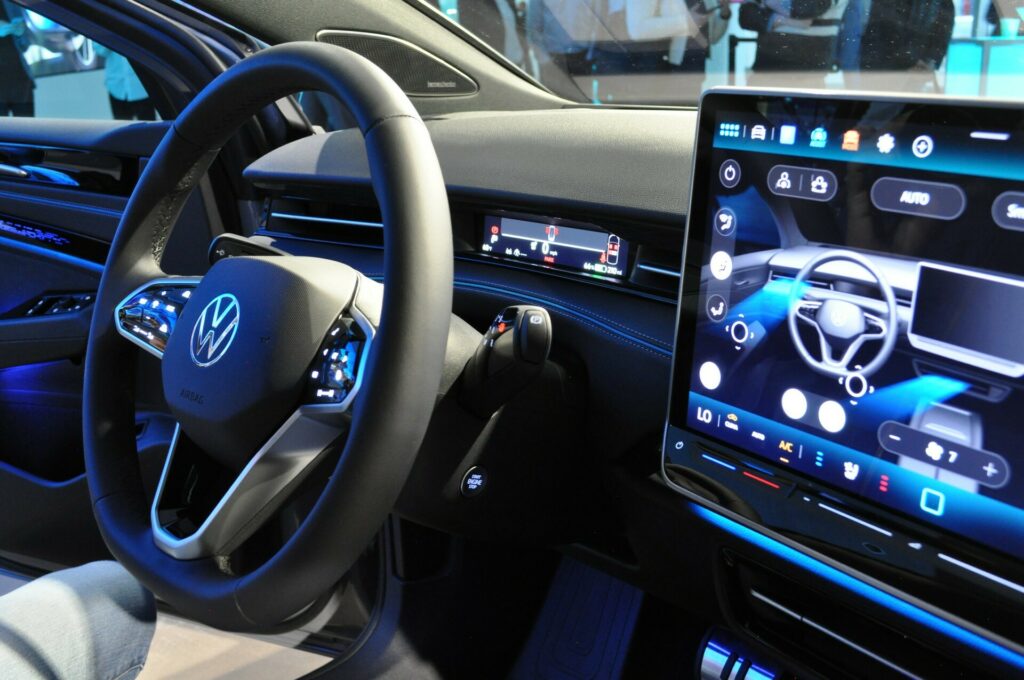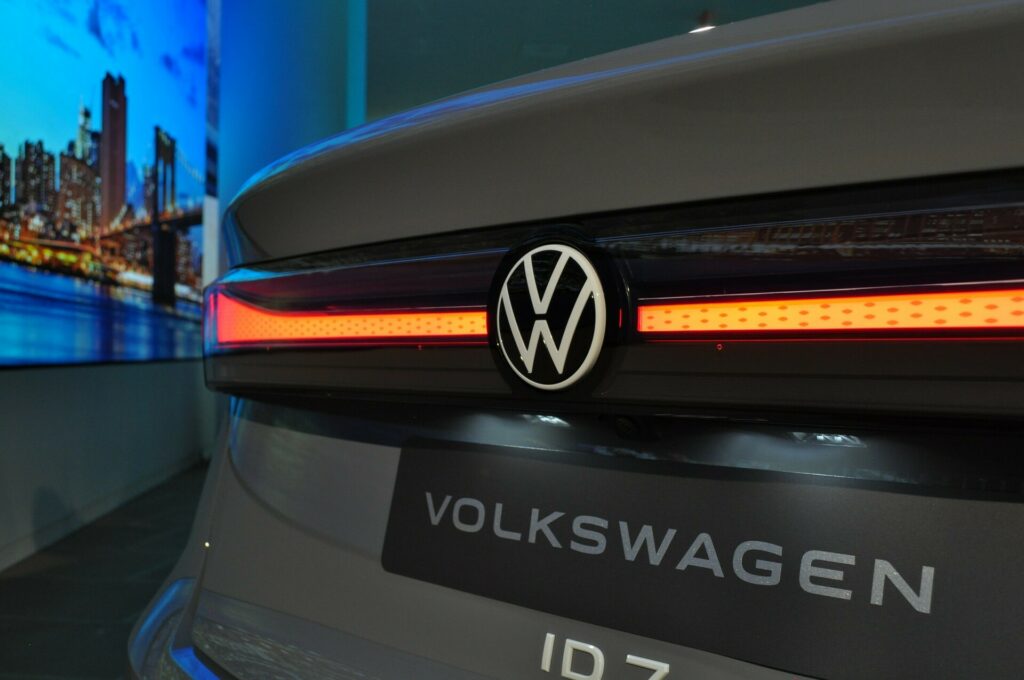The all-new Volkswagen ID.7 is a spacious and practical liftback that shows cars aren’t dead yet
1 hour ago

by Michael Gauthier
If you’re in the market for an affordable electric sedan in America, you’ll quickly discover that your options are limited. The Tesla Model 3 remains the default choice, but Hyundai’s Ioniq 6 is turning heads and attracting plenty of attention.
Aside from them, it’s a relative ghost town as most EVs are crossovers. While many of them are little more than hatchbacks with cladding, ‘proper’ cars are few and far between if you’re not shopping in the luxury segment.
That’s part of what makes the 2025 Volkswagen ID.7 interesting as its one of the few electric cars we’ve seen from a mass market brand. While the company refers to it as a sedan, the model is actually a liftback that opens to reveal a generous storage compartment with a two-tier load floor. Volkswagen hasn’t mentioned volumes at this point, but the cargo compartment features releases for the rear seats and they fold relatively flat.
A Handsome Electric Liftback
Photos Mike Gauthier/Carscoops
Volkswagen doesn’t have the best track record with sedans in America, but the ID.7 is handsome and instantly recognizable as a member of the ID family. While it’s certainly not as flashy as the Ioniq 6, the car is a vast improvement over the North American Passat, which was often described as appliance-like.
That description certainly doesn’t apply to the ID.7 as it features a stylish front end with slender headlights, which are connected by a thin illuminated strip. They’re joined by an expansive greenhouse, minimalist door handles, and aerodynamically optimized wheels. All of this results in one slick EV, which sports a drag coefficient of approximately 0.23.
advertisement scroll to continue
Unfortunately, it’s not all good news as the model’s charging port door isn’t powered. This is a minor inconvenience, but the door is a bit tricky to open and close.

The ID.7 might be fairly conservative, however it does pack a few party tricks including a panoramic glass roof that can transition from opaque to transparent at the push of a button. This technology isn’t new, but it has often been limited to luxury brands.
It’s also worth noting the ID.7 comes standard with gloss black pillars similar to the old Jaguar XJ. While they proved controversial on the latter car, they’re not much of an issue here as faux aluminum trim helps to break things up.
The ID.7 is larger than it appears as the model measures 195.3 inches (4,961 mm) long, 73.3 inches (1,862 mm) wide, and 60.6 inches (1,538 mm) tall with a wheelbase that spans 116.8 inches (2,966 mm). That’s 1.7 inches (43 mm) longer than the Passat and the EV has a 6.4 inch (163 mm) longer wheelbase.
A Minimalist, But Upscale Interior
Volkswagen hasn’t been coy about the ID.7’s premium positioning and that’s thankfully reflected in the cabin. High-quality materials abound and there are soft-touch accents at key touchpoints.
The most eye-catching features are illuminated trim and a 15-inch infotainment system. The latter dominates the interior and features an intuitive home screen that provides easy access to navigation, entertainment settings, the IDA voice assistant, and vehicle information. We only played around with the infotainment system briefly, but it seems fast and relatively straightforward. Users will also find volume and climate control touch bars beneath the screen, which are a welcome addition.
Elsewhere, there’s a flat-bottom steering wheel and a tiny digital instrument cluster. Volkswagen hasn’t said how small the display is, but it looks like someone slapped an early smartphone onto the dashboard. It will undoubtedly provoke strong reactions as it isn’t as full featured as a traditional digital instrument cluster, nor as futuristic as the ‘cluster less’ design used in the Tesla Model 3. In fact, it sort of resembles the small aftermarket clusters offered for the Tesla.

We’ll hold off on final judgments until we have a chance to drive the ID.7, but Volkswagen has previously said the display is basic by design as the ‘real cluster’ is the augmented reality head-up display that comes standard. We didn’t get a chance to see the HUD, but Volkswagen said it will enable drivers to be informed without having to take their eyes off the road.
The small cluster isn’t the only quirk as the ID.7’s start/stop button is mounted on the side of the steering column, instead of on the dashboard. This isn’t the first time Volkswagen has done this, but I’d prefer not to have to fumble around to get the car started.

Thanks to the generous dimensions, the ID.7 was plenty spacious for this 6’2” scribe. There’s tons of room up front and I had no problem slipping into the rear seats, which are comfortable and nicely bolstered. They have a good amount of legroom, but perhaps not as much as the 116.8 inch (2,966 mm) wheelbase would suggest. There’s also a fair amount of headroom and back seaters will find dedicated climate controls as well as butt warmers.
Speaking of equipment, the ID.7 is notable for featuring a high-tech climate control system and 14-way power front seats that have a Climatronic function. The latter use temperature and moisture sensors to activate heating or cooling as needed to keep occupants comfortable. The model can also be equipped with ergoPremium seats, which have ten air cushions in the backrest as well as two air cushions in the base to provide a reinvigorating massage.
282 HP And Up To 435 Miles Of Range

The ID.7 rides on the MEB platform and will be offered with two different battery packs. The entry-level ID.7 Pro has a 77 kWh battery and should enable the model to travel approximately 382 miles (615 km) in the WLTP cycle.
Upgrading to the ID.7 Pro S rewards buyers with a larger 86 kWh battery pack, which increases the range to around 435 miles (700 km). That isn’t the only change as the car’s DC fast charging capability climbs from 170 kW to 200 kW.
The battery powers Volkswagen’s new APP550 electric drive unit, which is essentially a rear-mounted electric motor that produces 282 hp (210 kW / 286 PS) and around 406 lb-ft (550 Nm) of torque. It gives the car a sizable advantage over the rear-wheel drive Ioniq 6, which only has up to 225 hp (168 kW / 228 PS) and 258 lb-ft (350 Nm) of torque.
Volkswagen has been coy about additional powertrain details, but officials suggested the ID.7 could have an EPA range in excess of 300 miles (483 km). We’re also expecting a dual-motor all-wheel drive system in the future, although that remains to be seen.
An Interesting EV That Arrives In America Next Year
Between electrification and the carpocalypse, many automakers have placed sedans on the back burner. It’s not hard to understand why, but it’s refreshing to see Volkswagen bring a new car to America, although we’ll have to wait until 2024 to get behind the wheel.
That’s a ways off and one of the biggest mysteries is pricing. However, Volkswagen has hinted the model won’t be cheap as they’ve described it as the flagship of the ID lineup. This suggests the car will be positioned well above the ID.4, which starts at $38,995 and climbs to $43,995 in Pro guise. Volkswagen has also confirmed the US-spec model will be imported from Germany and this means there will likely be tax credit implications.

stromectol 3mg online – buy generic carbamazepine order tegretol 400mg online
generic isotretinoin 10mg – isotretinoin pill brand linezolid
order zithromax 500mg online – tindamax 300mg uk purchase nebivolol generic
order generic prednisolone 40mg – order azipro 500mg for sale progesterone pills
buy neurontin online cheap – buy clomipramine without a prescription sporanox 100mg drug
lasix 40mg cost – lasix 100mg sale betnovate cream
semaglutide 14mg cheap – vardenafil 10mg generic buy cyproheptadine 4mg generic
I’m amazed by your remarkable aptitude to transform ordinary subjects into compelling content. Kudos!
cenforce buy online – buy cenforce 100mg without prescription glucophage 1000mg without prescription
atorvastatin buy online – buy norvasc 5mg for sale prinivil online order
I value how your writing reflects your distinct character. It feels like we’re engaging in a thought-provoking conversation.
I enjoy the way you write. Your post is easy to follow and comprehend. Thank you for sharing your thoughts.
methylprednisolone generic – buy cheap generic methylprednisolone buy generic aristocort for sale
buy desloratadine no prescription – priligy 90mg tablet order dapoxetine 60mg without prescription
buy cytotec 200mcg generic – buy orlistat 60mg sale diltiazem price
acyclovir 400mg brand – buy zyloprim 100mg pill crestor 20mg uk
buy generic domperidone for sale – buy generic sumycin 250mg cost cyclobenzaprine
order motilium 10mg – buy domperidone tablets buy flexeril paypal
purchase inderal online – inderal 10mg price buy methotrexate 2.5mg pills
order warfarin online cheap – buy metoclopramide pill order generic cozaar 25mg
purchase esomeprazole pill – topiramate pills order generic imitrex 25mg
meloxicam 15mg price – order celebrex pills flomax 0.2mg usa
order ondansetron 4mg pills – buy generic ondansetron 8mg purchase zocor for sale
valacyclovir 500mg cheap – forcan for sale online forcan cheap
modafinil 100mg tablet buy modafinil 100mg pill modafinil 200mg canada modafinil over the counter provigil sale order provigil pill buy provigil 100mg for sale